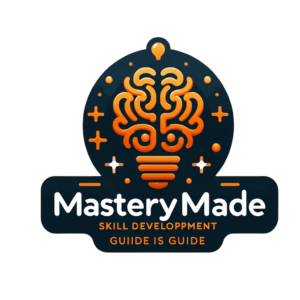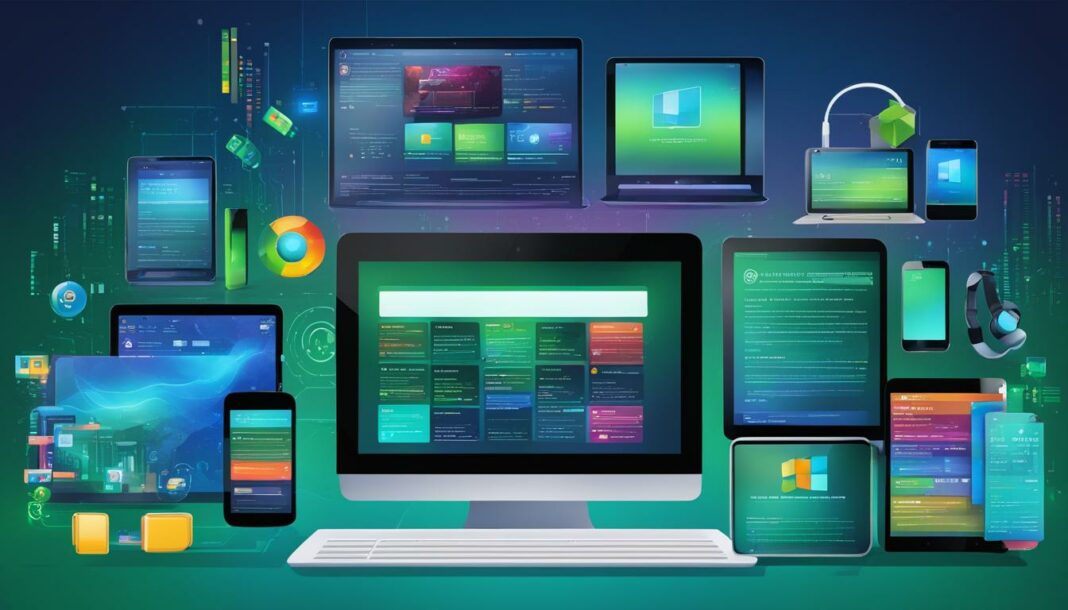We’re witnessing a transformative era where virtual education tools, online educational materials, and learning technology solutions are not just novelties but necessities. These innovations offer us a chance to redefine what it means to learn, empowering anyone with an internet connection to explore new realms of knowledge. As we delve into the digital age, we are committed to sharing the wealth of resources that make education more dynamic and accessible than ever before.
Whether you’re a student seeking to supplement your studies, a teacher looking to enhance your curriculum, or a curious mind eager to learn something new, the online world is brimming with opportunities. Our guide shines a spotlight on the most effective and engaging options out there. Join us in embracing these cutting-edge tools that strategically support and enrich the educational journey.
Key Takeaways
- Explore groundbreaking virtual education tools that redefine learning.
- Discover a diverse array of online educational materials for all levels.
- Identify how learning technology solutions can enhance your education.
- Understand the flexibility and customizability provided by online resources.
- Learn about the accessibility and convenience of education in the digital realm.
Exploring the Best Online Educational Platforms
In our journey through the expansive realm of online education, we’ve witnessed an incredible evolution of e-learning platforms. These digital havens of knowledge are not just a convenience but a lifeline to many pursuing education from a distance. As we assess the landscape of distance learning resources, we understand that the features and user experiences they offer can greatly impact the effectiveness and enjoyment of our learning journey.
Key Features of Leading E-learning Platforms
Stellar e-learning platforms distinguish themselves through a plethora of features designed to enhance the learning experience. At the core, we prioritize interactive content, ensuring that students can engage with the material in a dynamic manner. The essence of accessibility is non-negotiable, allowing learners to access courses anytime, from any device. We also emphasize the importance of platforms being mobile-friendly, granting learners the flexibility to study on-the-go. Lastly, the diversity of course options available can cater to a wide array of interests and career paths, underscoring the platform’s commitment to comprehensive education.
Comparing User Experiences Across Different Services
To truly understand the value of various e-learning platforms, we’ve gathered insights by comparing user experiences across different services. We’ve noted that platforms with intuitive navigation and personalized learning paths garner positive feedback for fostering a conducive learning environment. Additionally, the presence of community features like discussion forums and peer interactions enhances the overall experience, creating a sense of camaraderie among learners. Let us delve into the nuanced perspectives of actual users, learning which features shine brightest in propelling their education forward.
- Interaction and Engagement
- Accessibility and Convenience
- Mobile Experience
- Course Variety and Specialization
With vibrant e-learning platforms continuously emerging, the quest for knowledge is becoming more adaptive, personalized, and accessible than ever. It’s a thrilling time for us to explore and utilize these distance learning resources to fuel our passion for lifelong learning.
Understanding the Impact of Online Learning Resources
The advent of online learning resources has significantly changed the educational landscape, introducing a myriad of virtual tools that have become integral to modern learning. These tools provide unprecedented access to knowledge, thereby democratizing education and enabling a more personalized experience. As we uncover the impact these resources have had, it’s important to note not only their ubiquity but also the effectiveness of digital learning resources in enhancing educational outcomes.
The Role of Virtual Education Tools in Modern Learning
Virtual education tools have transcended the role of mere supplements to become central elements in the education process. From kindergarten to post-graduate studies, digital platforms offer learning solutions that cater to diverse needs and learning styles. The flexibility to learn at one’s own pace, accessibility from any location with internet access, and the capability to customize learning materials have made online resources indispensable in our pursuit of knowledge and skill development.
Statistics: How Online Resources are Shaping Education
Let’s delve into the statistics illuminating the profound impact of online learning resources:
| Statistic | Details | Impact |
|---|---|---|
| Adoption Rates | Over 6 million Americans are currently enrolled in online courses | Demonstrates the widespread acceptance of digital learning platforms |
| Learning Outcomes | Students using digital learning resources have shown a 9% improvement in test scores | Highlights the efficacy of online tools in improving academic performance |
| Engagement | Interactive online modules have 50% higher student engagement | Indicates how dynamic content can captivate and maintain student interest |
| Accessibility | 92% students say online learning resources are vital for time management and scheduling | Emphasizes the importance of these resources in making education more accessible for students with varying needs |
These figures underscore the increasingly pivotal role that online learning resources play not only in shaping educational delivery but also in enhancing the overall learning experience. By leveraging these digital learning resources, we’re witnessing a transformation in how knowledge is acquired and shared.
Navigating Online Study Materials for Academic Success
As we immerse ourselves in the digital frontier of education, the copious amounts of online study materials present a formidable challenge. However, these resources are the cornerstone upon which our academic ambitions can be built. We’ve devised a strategic approach to sift through an ocean of content on online educational platforms and extract the most pertinent materials poised to propel us toward academic excellence.
It commences with understanding the nature of the subject we’re tackling. Precise topic identification guides us to select appropriate materials. Here’s a practical example:
| Subject | Recommended Study Materials | Available Platforms |
|---|---|---|
| Mathematics | Interactive problem-solving tutorials | Khan Academy, Coursera |
| Literature | Analysis of literary works and themes | Project Gutenberg, SparkNotes |
| Science | Lab demonstrations and scientific theory explanations | edX, YouTube EDU |
| History | Documentaries and historical timelines | The Great Courses, History Channel |
Upon identifying the right resources, our next step is to create an efficient study schedule. Integration of materials into a manageable timetable fosters consistency and continuity in learning. Here’s how to delineate the perfect study plan:
- Allocate specific times for studying different topics.
- Utilize reminder apps to stay on schedule.
- Review materials in multiple formats to reinforce learning.
“Education is no longer confined to classrooms, and the world is your educational oyster.”
– This adage captures the versatile scope of
online study materials
that offer varied learning experiences for different learners. Our role is to guide you into harnessing them for success.
Lastly, evaluation and reflection are vital. After utilizing selected resources, take time to reflect on your comprehension and retention. This practice will not only reinforce the knowledge but also help you refine your study strategy continually.

Join us, as we embark on this transformative journey through the realm of digital education. With the proper guidance and an array of online study materials at our disposal, we’re well-equipped to conquer academic goals and soar to new heights of knowledge and proficiency.
Innovative Digital Learning Resources for Self-Paced Education
The age of technology has ushered in a new paradigm for learners everywhere, emphatically marking the era of self-paced education. No longer confined by the rigidity of traditional classroom settings, learners of all ages can now explore knowledge through a plethora of online learning resources that cater to their unique learning velocities. In our journey through the digital expanse, we have encountered an array of tools and platforms that exemplify the essence of tailored education. Let us delve into some of these groundbreaking resources.
- Khan Academy – Renowned for its extensive library of lessons, offering personalized dashboards and practice exercises to help learners track their progress.
- Coursera – Collates courses from universities around the world, giving access to quality education and professional certificate programs to those who need the flexibility to learn at their own pace.
- Udemy – A treasure trove for professional development, featuring courses taught by industry experts across various fields, from programming to personal development.
- edX – With a commitment to educational access, edX brings a university-like structure to the digital realm, offering programs that can be tackled step by step.
These platforms not only allow learners to control the speed of their education but also the space in which they learn. The comfort of completing a course from anywhere, and at anytime, is a luxury that was once just a figment of our imagination.
“To achieve greatness, one should live as if they will never die.” — François de La Rochefoucauld
Reflecting upon La Rochefoucauld’s words, we believe the path to greatness in education now lies in the digital domains of online learning resources. The limitlessness of self-paced learning ensures that our thirst for knowledge can be continually quenched, irrespective of time or earthly bounds.
| Platform | Type of Content | Pace Flexibility | Cost |
|---|---|---|---|
| Khan Academy | Academic Subjects | High | Free |
| Coursera | University Courses | Medium to High | Varies (Free to Subscription) |
| Udemy | Professional Skills | High | Per Course Fee |
| edX | University Programs | Medium to High | Free to Verified Certificate Fee |
In conclusion, the advent of these online learning resources has not only transformed our approach to self-paced education but also democratized the learning experience. Each platform and resource is a key that unlocks the door to personal development and intellectual growth. We stand on the threshold of an educational renaissance, one where knowledge is limitless and learning is unequivocally in our control.
How to Choose Quality E-Learning Platforms
Today’s technology-driven world has ushered in a plethora of e-learning platforms, each with its own set of features and benefits. As educators and learners, it’s essential for us to sift through this digital landscape to find learning technology solutions that not only meet but exceed our educational needs. To aid you in this quest, we’ve established a set of criteria to help determine the quality of these platforms.
Criteria for Evaluating Online Educational Materials
First and foremost, we must consider the content quality. High-caliber e-learning platforms provide comprehensive, accurate, and engaging materials that facilitate learning effectively. Another fundamental aspect to look for is a user-friendly interface. This ensures that navigation and course access are intuitive, allowing learners to focus on their studies instead of wrestling with complicated layouts. Lastly, robust support services such as technical assistance, tutoring, and community forums are crucial elements that can profoundly impact the overall learning experience.
Reviews: Top-Rated Learning Technology Solutions
Let’s turn our attention to some of the leading e-learning platforms, vetted by users and industry experts alike. Here’s a comprehensive table featuring a side-by-side comparison of top-rated learning technology solutions based on essential parameters like content quality, ease of use, and support offerings:
| E-Learning Platform | Content Quality | User Interface | Support Services |
|---|---|---|---|
| Coursera | High-quality courses from universities | Intuitive and clean | Responsive help center, community forums |
| Udemy | Wide variety of courses | User-friendly with personalized recommendations | FAQs, email support |
| edX | Academic courses from leading institutions | Straightforward with academic structure | Help center, discussion boards |
| LinkedIn Learning | Professional development focus | Seamless integration with LinkedIn profiles | Help portal, Q&A with instructors |
| Khan Academy | Comprehensive K-12 content | Simply structured for easy access | Email support, FAQs |
By considering these factors, we can make more informed decisions in selecting an e-learning platform that aligns with our learning objectives. Remember to always look beyond the surface and dive deep into what each platform can offer to truly enrich your educational journey.
Online Learning Resources
In an ever-connected world, distance learning resources and online learning resources offer unparalleled flexibility and access to a wealth of knowledge. To harness their full potential, it’s key to understand how to maximize their benefits effectively. Strategies that enhance engagement and improve retention can transform the learning experience, making it more efficient and rewarding for students across the globe.
Maximizing the Benefits of Distance Learning Resources
We find immense value in the broad range of resources available for online learning. However, the true measure of their worth is how well we can adapt these tools to fit our educational goals. Concentrating on interactive modules, incorporating multimedia elements, and fostering community interaction can significantly enhance student engagement. Additionally, implementing regular self-assessments and feedback loops contributes to refining the learning process, solidifying the knowledge gained through these innovative platforms.
Resources Categorized by Subject and Skill Level
Navigating the extensive seas of online resources can be daunting. Therefore, we’ve categorized these tools not only by subject matter but also by skill level to assist learners in pinpointing the exact resources they need.
| Subject | Beginner | Intermediate | Advanced |
|---|---|---|---|
| Mathematics | Basic Arithmetic | Algebra | Calculus |
| Science | General Science | Biology & Chemistry | Physics & Advanced Research |
| Humanities | Introduction to History | Literature Analysis | Philosophy Theories |
| Language Learning | Basics | Conversational Skills | Fluency and Advanced Grammar |
Whether starting from scratch, looking to brush up on existing skills, or pushing the boundaries of specialized knowledge, there’s a plethora of online learning resources tailored to facilitate every stage of your educational journey. By strategically selecting suitable content, learners can ensure they are on the most direct path to reaching their personal and professional aspirations.
Integrating Virtual Education Tools in Traditional Classrooms
The merger of traditional educational methodologies with modern virtual education tools has ushered in an era of blended learning. This approach synergistically combines offline instruction with the dynamism of online educational platforms, creating a rich, multifaceted learning experience. We’ve gathered insights from educators who have successfully navigated this integration, enhancing their curriculum with digital innovation.
Blended Learning: Combining Online and Offline Methods
In our journey of educational evolution, we recognize blended learning not merely as a trend but as a comprehensive strategy. It leverages the strengths of both in-person teaching and virtual education tools, ensuring a balanced and flexible approach. As we’ve implemented these strategies, we’ve observed a notable increase in student engagement and a deeper understanding of course material. Online platforms serve as a supplementary realm where students can revisit lectures, engage in interactive simulations, and access a vast repository of knowledge to complement their in-person learning.
Teacher Insights: Implementing Digital Tools in Curriculums
Introducing these online educational platforms does not come without its challenges, yet the rewards are manifold. The educators in our network have shared their experiences and techniques for folding digital tools into their curriculums. Their collective insights emphasize the importance of training and support for both teachers and students. By equipping educators with the necessary know-how, they become empowered to integrate these tools effectively, ensuring that their deployment in the classroom not only complements but elevates the learning experience.
As we continue to embrace these transformative educational practices, it becomes clear that the integration of virtual education tools into traditional settings is not just a possibility but a necessity. It allows us to meet diverse learner needs and prepare students for a future where digital proficiency is paramount. Through blended learning, we are building bridges between the classic and the contemporary, crafting a resilient and adaptable education system ready to face the challenges of tomorrow.
The Future of Online Educational Materials and Trends
As we venture further into the digital era, the realm of education is experiencing a paradigm shift. The future of online educational materials is an enthralling prospect, replete with innovations that promise to redefine how we interact with and consume knowledge. Anticipating these changes propels us to explore what lies ahead for online learning resources.
The continuous advancements in technology enhance our vision of the future. AI-driven customization, VR classrooms, and real-time collaborative platforms are just the beginning. These educational tools are set to become more immersive, personalized, and accessible, transforming the distance between educator and learner into a bridge of interactive experiences.
Online learning resources are swiftly adapting to the educational needs and lifestyles of learners globally. As we reflect on this evolution, let us highlight major trends shaping the future:
- Gamification of learning to boost engagement and retention
- Utilization of Big Data to provide insights into learning patterns
- Enhancing connectivity through Cloud-based Platforms
- The rise of Microlearning for focused, bite-sized education sessions
- Integration of Machine Learning to personalize educational content
Staying ahead of the curve requires us to not only be observers but active participants in these emerging trends. Our commitment to delivering top-tier online educational materials motivates us to continuously innovate and adapt, ensuring that we offer the most effective online learning resources available.
As pioneers in virtual education, we’ll keep our fingers on the pulse of these developments, ever ready to bring forth the next wave of educational excellence. A future brimming with possibility awaits us, and we invite you to join us on this exhilarating journey.
Addressing Challenges: Ensuring Accessibility to Online Study Materials
One of our core commitments is making sure that the accessibility of online study materials meets the needs of all learners, regardless of their background. Despite the leaps forward in the digital education space, socioeconomic challenges continue to pose significant barriers to many, inhibiting their access to vital educational content. We acknowledge these disparities and are dedicated to promoting inclusive education online. Let’s explore how we can break down these walls together.
Overcoming Socioeconomic Barriers in Virtual Learning
The digital divide is a stark reality for many families and learners, where limited access to the internet and devices can derail educational progression. We believe in a learning community where everyone has the opportunity to succeed — and this begins by bridging the gap created by socioeconomic differences. We’ve identified strategies that are paving the way to more equitable learning environments:
- Partnerships with organizations to provide subsidized or free internet access.
- Donation programs for devices to learners in need.
- Offline resources like downloadable lessons and textbooks.
- Targeted scholarships and grants for online course enrollment.
Together, we can leverage these approaches to ensure every student is equipped to thrive in a virtual learning ecosystem.
Tools and Tips for Inclusive Education Online
Creating an inclusive online educational experience is more than just overcoming material hurdles. Our educational approach must be as diverse as our audience, catering to a variety of learning needs and styles. Here are some invaluable tools and practical tips we’ve gathered to promote an inclusive educational sphere:
- Utilize platforms with adjustable text sizes and contrast options for visually impaired students.
- Embrace speech-to-text technology to aid students with writing difficulties.
- Incorporate closed captions and sign language interpretation in multimedia content.
- Design courses with neurodiversity in mind, allowing for various interaction and engagement levels.
With careful consideration and the implementation of these inclusive tools, we can ensure that our online study materials are not just widely available but also genuinely accessible.

We stand at the forefront of educational innovation, determined to transform potential hurdles into stepping stones for success. The digital age offers us an invaluable opportunity to rewrite the narrative of education — to create a world where accessibility of online study materials is not a privilege, but a universal right. We are excited to lead the charge and witness the growth that arises from truly inclusive education online.
Conclusion
Throughout our exploration of the dynamic world of online education, we’ve delved into the many facets that shape today’s learning environment. We’ve witnessed how e-learning platforms have become a cornerstone of modern education, their robust virtual education tools making knowledge more accessible than ever before. It has been our aim to guide you through this evolving landscape, equipping you with the knowledge to make the most of the online study materials at your disposal.
By embracing the digital resources that suit your personal and professional learning needs, you’re taking part in a broader educational revolution. Whether you’re mastering new skills, deepening your expertise, or simply satiating your curiosity, the potential for growth is boundless. The insights we’ve shared on navigating, evaluating, and integrating these resources aim to enhance your educational journey, providing a strong foundation for success in the digital age.
As we close this guide, it is our hope that the perspectives we’ve detailed will serve as a beacon, illuminating the path to your academic and career advancements. The future of education is unfolding before us, rich with e-learning platforms and virtual education tools, and it’s ours to shape. Let’s collectively move forward with the confidence that these digital contributions to learning will continue to transform our understanding and engagement with the world around us.
FAQ
What are the primary benefits of using virtual education tools?
Virtual education tools provide flexibility, customization, and accessibility to learners, allowing them to access quality education from anywhere, at any time. These tools support a range of learning styles through interactive content and personalized learning paths.
How do I choose the best e-learning platform for my needs?
When selecting an e-learning platform, consider its interactive features, the variety of course options, accessibility on different devices, and how well it aligns with your learning objectives. User reviews and comparative experiences can also guide your decision.
Can online educational materials truly replace traditional classroom learning?
Online educational materials complement traditional classroom learning by offering additional resources and flexibility. While they may not fully replace in-person learning, they provide valuable opportunities for supplemental education and can be especially beneficial for distance learning and self-paced education.
How can I effectively navigate and use online study materials for academic success?
To effectively navigate online study materials, start by setting clear learning goals, organizing your study schedule, and actively engaging with interactive resources. Utilize filters and search functions on educational platforms to find materials that match your subject interest and skill level.
What makes digital learning resources ideal for self-paced education?
Digital learning resources provide learners with the ability to control the pace of their education. They offer a wealth of materials that can be accessed at any time, accommodating various learning speeds and allowing for repetition and review as needed.
What should I look for in high-quality learning technology solutions?
In high-quality learning technology solutions, look for content accuracy, a user-friendly interface, reliable support services, a variety of interactive and multimedia elements, and feedback mechanisms that help track and assess your learning progress.
How can distance learning resources maximize benefits for learners?
To maximize the benefits of distance learning resources, learners should take advantage of the flexibility they offer, engage with interactive elements, participate in online discussion forums, and practice time management to maintain a consistent study routine.
What are some strategies for integrating virtual education tools into traditional classrooms?
Strategies for integrating virtual education tools in traditional classrooms include adopting a blended learning approach, using online resources to supplement instruction, encouraging collaborative projects using digital platforms, and incorporating multimedia elements to enhance engagement.
What trends are emerging in the use of online educational materials?
Emerging trends in online educational materials include the rise of gamification, increased use of artificial intelligence for personalized learning experiences, adoption of virtual reality environments, and a growing emphasis on competency-based education.
How can we address accessibility challenges to ensure all students can access online study materials?
Addressing accessibility challenges involves providing financial aid or free resources to those in need, ensuring content is available in multiple formats for various disabilities, and offering support and training for both educators and learners to utilize digital materials effectively.











